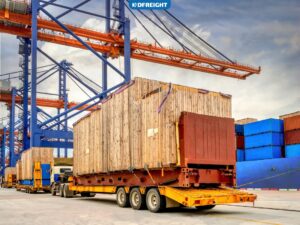Air and ocean freight is part of an extensive industry. In transporting shipments, the client and the company face problems that affect both the customer and the corporation. You can improve your experience by understanding these challenges. In today’s world of freight, intra-city, extra-city, and worldwide transportation are all options. This article compares two types of international transportation: sea and air freight.
Table of Contents
Air and Ocean Freight Forwarders Challenges
The air and ocean freight industry is responsible for the transport of goods and materials around the world. It is a vital part of the global economy, and the movement of goods significantly impacts the environment. There are several challenges facing the air and ocean freight industries regarding air and ocean transport. The first is the increasing cost of fuel. The price of oil has risen sharply in recent years, which has had a knock-on effect on the cost of shipping. This is particularly challenging for the air and ocean freight industry, as fuel is one of its biggest costs.
The second challenge is the regulation of emissions. There are increasing restrictions on the emissions that can be released into the atmosphere, which is particularly challenging for the freight industry. Ships and aircraft are major sources of emissions, and the air and ocean freight industry is working hard to find ways to reduce these emissions and become more sustainable. The third challenge is the increasing demand for freight services. As the world economy grows, so does the demand for freight services. This is putting pressure on the freight industry to find ways to increase capacity and efficiency.
The air and ocean freight industry is facing several challenges, but it is also working hard to find solutions. These solutions will help to reduce costs and emissions and increase capacity. Every industry confronts obstacles in its sector of activity, which can be managed by understanding the details and finding appropriate solutions. Let’s look at the challenges a shipping company may face.
Demand Shock
A demand shock is a sudden increase or decrease in the demand for a good or service. This can significantly impact the air and ocean freight industries, leading to a sudden increase in the demand for freight services. This can put pressure on the industry to find ways to increase capacity and efficiency. A demand shock can be caused by several factors, including economic growth, changes in consumer demand, natural disasters, and political instability. The freight industry is particularly vulnerable to demand shocks due to the global nature of its operations.
A sudden increase in demand in one part of the world can affect the demand for freight services in other parts of the world. The freight industry is working hard to find ways to mitigate the impact of demand shocks. These solutions include diversifying the types of goods and services it transports, increasing capacity and efficiency, and developing new technologies. Congestion and increased demand are causing further issues in this industry.
Port-related Issues
There is always a possibility that delays at ports will cause your cargo to be held up in the ocean freight field. These problems could be an accident, labor shortage, warehousing trouble, or, as it was said, congestion. The freight industry is responsible for the transport of goods and materials around the world. A significant proportion of this freight is transported by ship, and ports play a vital role in the operation of the freight industry. There are several challenges facing the freight industry regarding port-related issues. The first is congestion.
Congestion at ports can lead to delays in transporting goods, which can knock on the supply chain. The second challenge is security. Ports are a major target for terrorist attacks, and the freight industry is working hard to find ways to improve security. The third challenge is the increasing cost of port infrastructure. The freight industry is facing rising costs regarding the construction and maintenance of port facilities.
Container Shortage
Sometimes finding the proper container in the right size and adequate amount can be difficult; therefore, finding a reliable carrier is essential in the air and ocean transportation industries. A container shortage is a challenge facing the freight industry. A container shortage can lead to delays in the transport of goods, and this can have a knock-on effect on the supply chain. A container shortage can be caused by several factors, including an increase in the demand for freight services, a decrease in the supply of containers, and port congestion. The air and ocean freight industry is working hard to find ways to mitigate the impact of a container shortage.
Insufficient Storage Space in Warehouses
One of the challenges faced by the air and ocean shipping industries is insufficient storage space in warehouses. Cargoes frequently require storage before being shipped, and the entire process will be postponed if insufficient space exists. This is often due to the high land costs and the need for warehouses close to transportation hubs. As a result, many warehouses are overcrowded and do not have enough space to store all the needed products. This can lead to products being stored in inappropriate locations, damaging them or making them difficult to find. It can also lead to products being stored in unsafe conditions, posing a risk to workers and customers.
The solution to this challenge is to invest in larger warehouses or build new ones. This will allow the air and ocean industry to have the space it needs to safely and efficiently store products. It will also create new jobs in the construction and warehousing industries.
Unexpected Occurrences
can also damage infrastructure and lead to the closure of transportation routes. As a result, air and ocean logistics must be prepared to deal with these events and have contingency plans in place. The solution to this challenge is to have a robust risk management system in place. This system should identify potential risks and plan to mitigate them. It should also be able to quickly adapt to changes in the environment and respond to unexpected events.
Fuel Price
Fuel prices are a major challenge for the air and ocean logistics industries. The cost of fuel can fluctuate significantly, and this can have a significant impact on the cost of transporting goods. Fuel prices can also impact the environment, as the emissions from aircraft and ships can contribute to climate change. The solution to this challenge is to invest in fuel-efficient technologies. This will help reduce fuel costs and emissions from logistics operations. It will also help reduce fuel prices’ impact on the environment.
Policy Implementation
Policy implementation is a major challenge for the air and ocean logistics industries. Many international laws and regulations govern the transport of goods. These laws and regulations can be complex and difficult to understand. They can also change frequently, making it difficult for logistics companies to keep up with them. As a result, the logistics industry must be able to adapt to changes in policy quickly.
The solution to this challenge is to invest in software that can help to manage compliance with international laws and regulations. This software should be able to track changes in policy and help logistics companies adapt to them. It should also be able to guide the best way to comply with laws and regulations.
Customer Preferences
Customer behavior is a function of social and economic conditions and can change in certain situations. Any changes should be attended to, and equipment and routes should be substituted according to client preferences. Customer preferences are a major challenge for the air and ocean logistics industries. Customers often have specific preferences for the products that they purchase. They also have specific preferences for how they want their products to be delivered. As a result, logistics companies must be able to adapt to changes in customer preferences quickly. The solution is to manage customer behavior, track changes in customer preferences, and provide guidance on the best way to meet customer preferences.
Oversized Cargo
When it comes to shipping huge, oversized cargo, ocean freight is a better choice than aviation. The above-mentioned article, which is available on our website, goes into detail about the problems that heavy cargo can cause.
Scheduling
When you have a short amount of time to convey your cargo and need it handled quickly, using air services is recommended because one of the disadvantages of ocean freight is the time it takes. Many different factors must be considered when scheduling transportation operations. These factors include the availability of aircraft and ships, the time required for loading and unloading, and the time required for transit. As a result, the logistics industry must be able to adapt to changes in the schedule quickly.
Environmental Concerns
Customers are increasingly drawn to environmentally conscious organizations that employ green technologies. Using such technologies is, of course, coupled with higher expenses. Ocean freight is the most environmentally friendly of all the transportation methods. Green technology should be pursued with other methods to avoid losing market share and customers.
Blank Sailing
Blank sailing is when a ship sails without any cargo. This can happen for various reasons, including bad weather, mechanical problems, and political unrest. Blank sailing can disrupt the supply chain and cause delays in the delivery of goods. As a result, the logistics industry must be prepared to deal with blank sailing and have contingency plans in place. When a corporation does not have enough goods to fill a container, it causes extra charges in the case of transport in that situation. Finding compatible partners to divide the space could be an answer in this situation.
Damage
The transport of goods can be a risky business, and damage to shipments is a common occurrence. Damage to shipments can occur due to weather events, accidents, and even sabotage. Damage to shipments is always a possibility and is one of the inevitable challenges for the industry. As a result, shipping insurance can help to reduce some of these concerns.
Technology Adoption
Companies are now obligated to use technology; otherwise, they will fall behind their competitors and be forced out of their industry. The use of technology and its adaptation are two distinct things. Today, companies incorporate technology into their operations, such as correspondence, paperwork, internet meetups, etc. Successful and leading companies, on the other hand, employ technology to grow and improve their businesses. They upgrade their infrastructure and utilize technology to develop innovative and smart shipping.
Customers Challenges
The ever-changing landscape of the air and ocean logistics industry presents many challenges for customers. They must constantly adapt to new technologies, regulations, and market conditions to stay competitive. In addition, they must manage their resources effectively to ensure that their supply chain is efficient and cost-effective. The following are some of the biggest challenges faced by customers in the logistics industry:
Company Selection
The first step toward a flawless air and ocean freight process is to select a devoted and dependable freight forwarder for clients. Consider firm background, certificates and licenses, customer service, vast network, clear pricing and payment, shipping insurance, and reacting to customer concerns to reduce transportation risk.
Complexity
Some shipments may face issues, and by being aware of the problem, you can take the necessary actions to resolve it. Hazardous goods, oversized cargo, animals, and coffins are examples of such loads. So keep in mind that their process will take longer than other cargoes.
Cargo Damage
If your goods are damaged during the storage, handling, loading, or unloading procedure, you will be compensated according to your contract and the type of cargo insurance you have. However, your cargo has been harmed, and this risk must not be overlooked.
Contract
Attempt to understand all of the contract’s terms in air and ocean freight, read it, negotiate non-acceptable clauses, and refuse to accept the contract if it is unclear.
Delivery Delay
Always factor in the probability of delays in this industry, and if you urgently need to receive your shipment, include this in the contract or begin the transfer procedure sooner.
General Overview
This paper summarizes the challenges of the preceding year’s logistics (air and ocean freight). Hiring a dependable freight forwarder is the greatest method to minimize costs and optimize the entire process. Here at DFreight we offer you all kinds of shipping and ensure we deliver on our promises and meet your expectations.
Between air and ocean freight, which one is cheaper?
Air and ocean freight currently, ocean freight is much cheaper than air freight.
Does the price of fuel affect the cost of transportation?
Yes, it does; transportation prices increase as fuel prices rise.
Do exceptional loads necessitate additional permits?
Additional permits may be required depending on the type of cargo, which the firm can arrange for you.
What factors influence sea cargo shipping rates?
Sea cargo shipping rates are influenced by factors such as distance, type of goods, port fees, currency exchange rates, and fuel costs.














